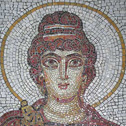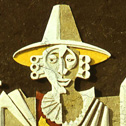Terminology
Mural art
There are 3 central classical mural techniques: mosaics, mural painting (Fresco, Al secco), and sgraffito. All of them connect with wall or ceiling and have two main purposes: function and beauty. Aesthetics aside, mural art can help architects and designers to underline or hide qualities of a building's interior (or exterior). For instance, it can make low ceilings seem higher, a small space feel bigger and also add interest to an uninspiring part of a building's design. Specifically mural art can help through the use of perspective, 3D/volume effects, colours, scale, composition and theme.
Mosaic
The most resilient of all mural forms, mosaics are easy to clean, can be used pretty much anywhere (including floor surfaces), and have colours which don't fade. Made with pieces of stone, coloured glass or ceramics, it represents the most luxurious mural art form as the materials are expensive and because it takes much longer to make for the mural artist.
«Fresco» & «Al secco»
Some instantly associate Fresco with mural painting, believing them to be one and the same. The reality is that Fresco («fresh» in Italian) is a particular century-old mural technique, using water-soluble paint directly on wet plaster. The paints and wet plaster mix, allowing the absorbed pigments to survive for many centuries. Al secco�(«dry» in Italian) painting in contrast, is done on dry plaster. This is the way most mural artists of today paint with the pigments simply sitting on the surface of the wall — do not become part of the plaster, as in�buon («real» in Italian) fresco. As a result Al secco paintings are less durable. In fact the colours may even flake off the wall as time goes by. But a long time needs to have passed and unless you're planning of living for a few centuries at least, al secco painting is more than adequate. It is much easier to paint with and there's no stress of worrying if the plaster will dry out!
Sgraffito
An often overlooked part of mural art. It represents a technique of wall decor produced by applying layers of plaster tinted in contrasting colours. It is generally used for decorative effects on the building exteriors. But even in the modern interior it can be used working particularly well with rough surfaces/surroundings such as exposed brickwork.




